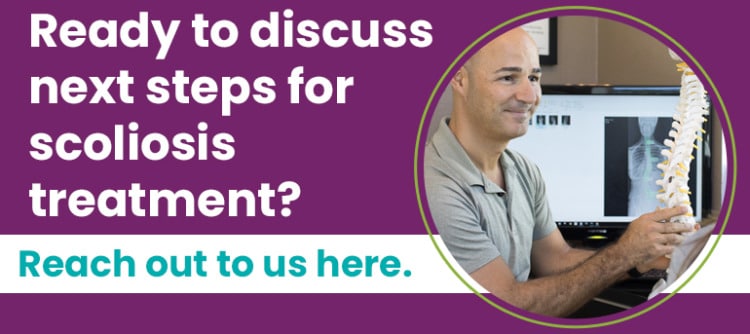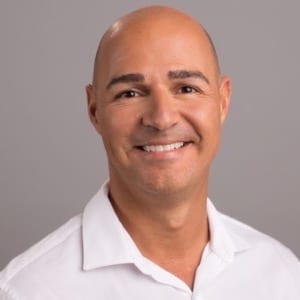Finding the Best Scoliosis Surgeon: Tips and Recommendations

Scoliosis surgery is an invasive spinal surgery with a number of potential risks, side effects, and complications, but having the best possible scoliosis surgeon can help reduce the risks. In many cases, scoliosis can be responsive to nonsurgical treatment options.
Scoliosis surgery is a type of spinal fusion, and when it comes to choosing a surgeon, important factors to consider include experience, training, communication, referrals, and reviews, and it's also important to understand that surgery isn't the only treatment option.
Before getting to the specifics of scoliosis surgery and how to find the right doctor, let's talk about the importance of treatment, and when it's started.
Table of Contents
Scoliosis is Progressive
Scoliosis is a progressive condition, so its nature is to get worse over time, and the condition's severity levels include mild scoliosis, moderate, severe, and very severe scoliosis.
Scoliosis causes the spine to develop an unnatural sideways curvature of the spine that rotates, making it a 3-dimensional condition.
Progression means the size and rotation of the abnormal spinal curvature is going to increase, along with its effects.
The main symptoms of scoliosis in children involve postural changes such as uneven shoulders, uneven hips, development of a rib cage arch, and changes to movement can also occur as balance, coordination, and gait are affected.
When it comes to childhood scoliosis, in particular, being proactive with treatment is key because progression is triggered by growth, so the more growth a patient has to go through before reaching skeletal maturity, the more potential progression there may be.
Progression has to be the focus of scoliosis treatment because the spinal condition won't simply resolve on its own, and treatment is about addressing an ongoing condition.
While conservative nonsurgical scoliosis treatment works towards preventing progression, traditional surgical treatment has a different approach.
Surgical Scoliosis Treatment
Scoliosis surgery is a type of spinal fusion and involves fusing the curve's most-tilted vertebrae into one solid bone and attaching metal rods to the spine to hold it in place.
Scoliosis surgery is risky, as all surgical procedures are.
Spinal fusion surgery is a traditional treatment response, and as it doesn't have a strategy for addressing scoliosis while mild, a common recommendation is to watch and wait, and in cases where progression into the severe classification occurs, or when patients are diagnosed with severe scoliosis, spinal fusion is recommended.
The risks associated with spinal fusion surgery include excessive blood loss, nerves damage, infection, and adverse reaction to hardware used.
The long-term effects of living with a fused spine is a spine that's weaker and more vulnerable to injury and is less flexible for a reduced range of motion.
The goal of spinal fusion is to stop scoliosis from progressing, and when it comes to the potential risks, these can be minimized by finding the right surgeon.
Finding the Right Scoliosis Surgeon
The referral process should start with a patient's trusted primary physician; often they can point patients in the right direction.
Online resources and reviews are more accessible than ever before, so don't hesitate to look up a number of surgeons you're considering, and a helpful online resource is the Scoliosis Research Society's Find a Specialist Tool.
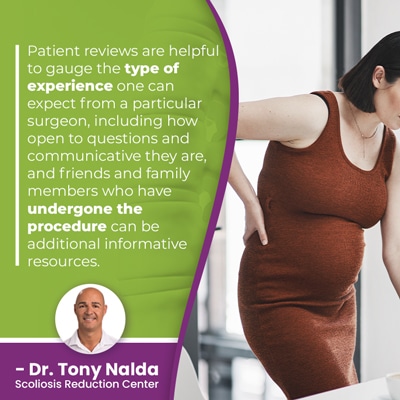 Patient reviews are helpful to gauge the type of experience one can expect from a particular surgeon, including how open to questions and communicative they are, and friends and family members who have undergone the procedure can be additional informative resources.
Patient reviews are helpful to gauge the type of experience one can expect from a particular surgeon, including how open to questions and communicative they are, and friends and family members who have undergone the procedure can be additional informative resources.
A surgeon's training and certifications are also important, along with their experience. A parent might feel more comfortable with a surgeon performing their 50th spinal fusion than their second or third surgery.
Ensuring that qualifications and certifications are current and up to date can mean a surgeon who is in the know when it comes to the latest surgical techniques and innovations.
Finally, it's important to establish an open and trusting rapport with a treatment provider, whether surgical or nonsurgical. Patients need to feel comfortable and confident that they are all on the same team.
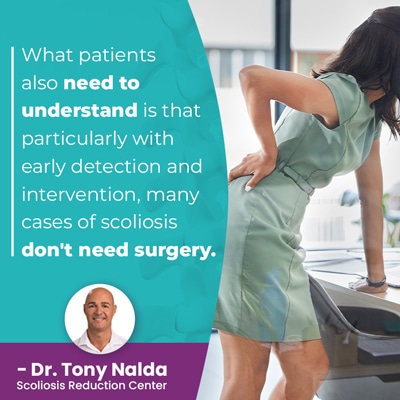 What patients also need to understand is that particularly with early detection and intervention, many cases of scoliosis don't need surgery.
What patients also need to understand is that particularly with early detection and intervention, many cases of scoliosis don't need surgery.
Nonsurgical Treatment Options
While traditional treatment was the dominant choice for many years, modern conservative treatment offers a nonsurgical treatment alternative with proven results.
There are no treatment guarantees, but early detection and intervention is associated with treatment success, and nonsurgical techniques value starting treatment as close to the time of diagnosis as possible.
Conservative treatment has the goal of managing progression through correction.
Again, there are never treatment guarantees, but here at the Scoliosis Reduction Center®, results speak for themselves.
Conservative treatment doesn't carry the same potential risks, side effects, and complications as surgical treatment, and it's integrative so combines multiple different types of treatment.
Conservative treatment plans are also fully customized as treatment disciplines can be adjusted and apportioned accordingly based on how a patient's spine is responding to treatment and/or growth.
Conservative treatment combines the power of condition-specific chiropractic care, physical therapy, corrective bracing, and rehabilitation.
Chiropractic Care
Condition-specific chiropractic care has the goal of increasing the spine's flexibility and improving its alignment; this can involve a series of techniques and manual adjustments.
If the position of the curve's most-tilted vertebrae is improved, this reduces the curve size on a structural level.
Improving the spine's alignment doesn't just impact the spine positively, but also its surroundings, and the entire body; a spine that's not aligned means the body is not aligned, especially over time with progression and increasing postural changes.
Restoring balance to the spine means improving the body's overall balance, posture, and stability.
Chiropractic care can work towards increasing spinal flexibility, and this makes it more responsive to treatment and less vulnerable to injury; remember, the more rigid a spine is, the weaker it is (a potential side effect of spinal fusion).
Physical Therapy
Scoliosis-specific physical therapy has a lot to offer.
There was a time when the place of exercise was questioned in scoliosis treatment, but over the years, we've learned this isn't the case, and entire exercise-based treatment programs have developed.
Physical therapy can work towards improving the spine's surrounding muscle balance and strength for more support and stability for the spine, and this helps support the structural changes occurring with a curvature reduction.
It's not just the spine that maintains its healthy curve and alignment; it needs to be surrounded by strong musculature.
Physical therapy can also restore posture and teach postural awareness through the use of mirror image exercises that show patients how to hold their spine and bodies during movement to counteract their curve and hold treatment results.
Corrective Braces
Bracing has been used as a form of nonsurgical scoliosis treatment for years, and modern corrective bracing has a lot to offer in terms of improving the curve size, posture, and complementing the other facets of treatment.
A brace is an orthotic device that's worn tightly around the torso and applies pressure with the goal of improving the spine's position.
As growing spines are more malleable, corrective bracing is a key treatment discipline in childhood scoliosis.
The modern ScoliBrace can push the spine into a straighter alignment, and because it's designed with movement in mind, it can be paired with a scoliosis-specific exercise program to further results.
And rehabilitation involves the prescription of scoliosis exercises that can be performed from home to further heal and stabilize the spine.
Conclusion
When it comes to finding the best scoliosis doctor for surgery, there are a number of resources available from online treatment provider Search tools to online patient reviews and testimonials.
Starting the referral process with a trusted physician can also point patients in the right direction.
Asking a number of questions to potential treatment providers can help too; patients can gauge how well the surgeon communicates and how open they are to inquiries.
Also, a surgeon's experience and training certifications are important to ensure they can offer the type of results a patient is looking for.
Scoliosis surgery can straighten a bent spine and stop it from progressing, but spinal surgery is invasive, and patients need to be aware that surgical treatment isn't the only option.
There are no treatment guarantees, but there is also no harm in being proactive with treatment and trying a less-invasive nonsurgical treatment plan first, ensuring the risks associated with spinal fusion are necessary.
Spinal fusion can leave the spine more rigid, less flexible, and increased back pain is also common. In addition, a spine that's fused is fused for life. If there are any complications with the hardware in the future, the only recourse is more surgery.
Here at the Center, I spend a lot of time educating patients on the different treatment options available because I want patients to make informed decisions.
Dr. Tony Nalda
DOCTOR OF CHIROPRACTIC
After receiving an undergraduate degree in psychology and his Doctorate of Chiropractic from Life University, Dr. Nalda settled in Celebration, Florida and proceeded to build one of Central Florida’s most successful chiropractic clinics.
His experience with patients suffering from scoliosis, and the confusion and frustration they faced, led him to seek a specialty in scoliosis care. In 2006 he completed his Intensive Care Certification from CLEAR Institute, a leading scoliosis educational and certification center.
About Dr. Tony Nalda
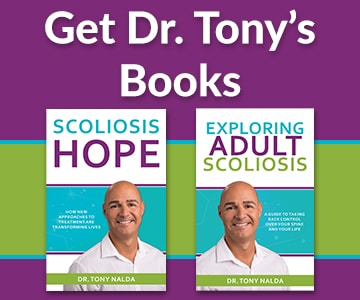 Ready to explore scoliosis treatment? Contact Us Now
Ready to explore scoliosis treatment? Contact Us Now